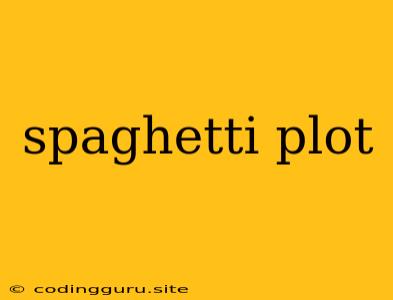What is a Spaghetti Plot?
A spaghetti plot, also known as a spaghetti graph, is a type of line chart that displays multiple time series data on a single graph. The lines on the plot resemble strands of spaghetti, hence the name. It's often used to visualize trends and patterns in data over time.
Why is it called a spaghetti plot?
The term "spaghetti plot" comes from the appearance of the chart. The multiple lines representing different time series can appear like tangled strands of spaghetti, especially if there are a lot of lines on the plot.
When is a spaghetti plot useful?
Spaghetti plots are useful for:
- Identifying trends: The overall direction of the lines can show if there's an upward or downward trend in the data.
- Comparing different time series: It's easy to see how different time series behave relative to each other.
- Detecting outliers: Unusual spikes or drops in the data are easier to spot.
When is a spaghetti plot not useful?
Spaghetti plots can be difficult to read if there are too many lines on the plot. It can be challenging to distinguish individual lines and interpret the trends. In such cases, other types of charts, like stacked area charts or grouped bar charts, may be more appropriate.
How to create a spaghetti plot
You can create a spaghetti plot using various software and programming languages:
- Excel: Excel allows you to create simple spaghetti plots by using line charts with multiple series.
- R: The
ggplot2package provides a powerful way to create highly customizable spaghetti plots. - Python: Libraries like
matplotlibandseabornoffer extensive options for generating sophisticated spaghetti plots.
Example of a spaghetti plot
Imagine you want to track the daily sales of five different products in a store. A spaghetti plot would allow you to visually see how the sales of each product change over time:
- Each line represents a different product.
- The x-axis represents time (days).
- The y-axis represents sales volume.
By looking at the plot, you could easily identify which product has the highest sales, which product has the most fluctuating sales, and any noticeable trends or patterns.
Tips for creating a spaghetti plot
- Keep the number of lines reasonable: Too many lines will make the plot cluttered and hard to read.
- Use different colors and line styles: This helps to distinguish the different lines and improve clarity.
- Add labels and annotations: Label the lines and add annotations to highlight important features or points of interest.
- Consider using smoothing techniques: Smoothing the lines can make the plot easier to interpret and highlight underlying trends.
Conclusion
Spaghetti plots are a valuable tool for visualizing multiple time series data and understanding how they change over time. They are particularly helpful for identifying trends, comparing different series, and detecting outliers. However, it is important to use them thoughtfully, considering the number of lines and ensuring the plot is clear and easy to interpret.
